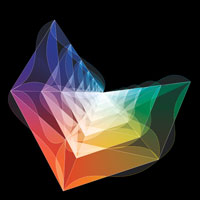Quantum Gravity
By Natalie Wolchover
Quanta, March 2014
Edited by Andy Ross
Physicists are searching for a theory of quantum gravity. Most
physicists believe that gravitons give rise to gravity. But calculations
of graviton interactions yield infinities.
Supergravity posits
the existence of new particles that mirror graviton effects. It has long
been assumed to suffer from the infinity problem, but no one was sure.
Using new tools, UCLA theorist Zvi Bern and his team are now calculating
these gravitational interactions and making sense.
General
relativity describes gravity perfectly on the macroscopic scale but goes
wrong for gravitons. Feynman diagrams represent the scattering
amplitudes for all the possible particle interactions, and physicists
sum them to calculate the probabilities. Each new level of precision
requires drawing exponentially more diagrams. For some particle
interactions infinities cancel, but for gravitons they don't.
Supergravity adds new symmetries to the theory. If one type of particle
exists, then so does its opposite. The N = 8 supergravity variant has
eight such doublings, and the mirror-image particles let physicists
cancel some possibilities. This approach works for 4-loop precision. But
experts suspect infinities reappear for more loops.
Years ago,
Bern and colleagues developed techniques for speeding up scattering
amplitude calculations. Applying the techniques to supergravity
calculations, they saw that gravitons behave like two copies of gluons,
the strong nuclear force bosons in quantum chromodynamics. The success
of QCD suggests that supergravity might work.
Bern and his
collaborators will test N = 8 supergravity by calculating what happens
when gravitons collide to 5-loop precision in a fictional world with 4.8
spacetime dimensions. The 5-loop calculation for 4.8D roughly
corresponds to a much more difficult 7-loop calculation in 4D.
Black holes involve particles colliding with the Planck energy. At such
high energies, an infinite number of Feynman diagrams are needed to make
even a rough approximation of the scattering amplitude. This cripples
calculations in N = 8 supergravity and suggests information is lost,
which is a problem. To solve it, physicists suspect they will ultimately
have to give up locality.
Abandoning locality could mean
abandoning Feynman diagrams, which assume locality. In one approach to
calculating scattering amplitudes in supersymmetric quantum physics,
gluon scattering amplitudes are computed by measuring the volume of an
amplituhedron, a geometric object whose shape is determined by the
number and properties of the gluons involved in an interaction. The
approach does not assume locality.
The amplituhedron corresponds
to interactions between gluons, and so the fact that gravitons behave
like two copies of gluons could point the way forward. If the latest
supergravity calculation of graviton scattering in 4.8D works, then N =
8 supergravity may be a viable theory. If not, something is missing.
Many are looking to string theory.

The Amplituhedron
By
Natalie Wolchover
Quanta, September 2013
Edited by Andy Ross
Quantum field theory would be simpler if interactions previously calculated
with long formulas matched the volume of the corresponding amplituhedron.
A geometric version of QFT could also help in the search for a theory of
quantum gravity by removing locality and unitarity. Locality is the notion
that particles can interact only when contiguous in spacetime. Unitarity
says the probabilities of all possible outcomes of an interaction add up to
one. The concepts are central to QFT.
The new geometric approach to
particle interactions avoids assuming locality and unitarity, which break
down in quantum gravity. If spacetime and probabilities emerge from the
geometry, a geometric object related to the amplituhedron might describe
gravity and show why particles appear to move in 4D spacetime.
The
amplituhedron encodes scattering amplitudes representing the probability
that a certain set of particles will turn into certain other particles upon
colliding. The volume of a master amplituhedron with an infinite number of
facets represents the total amplitude of all physical processes.
Lower-dimensional amplituhedra in the master structure correspond to
interactions between finite numbers of particles.
String theory is a
candidate theory of quantum gravity. A duality exists between string theory
and QFT in a different number of dimensions. The amplituhedron research
could show how our universe emerges out of pure geometry.
|
|
|